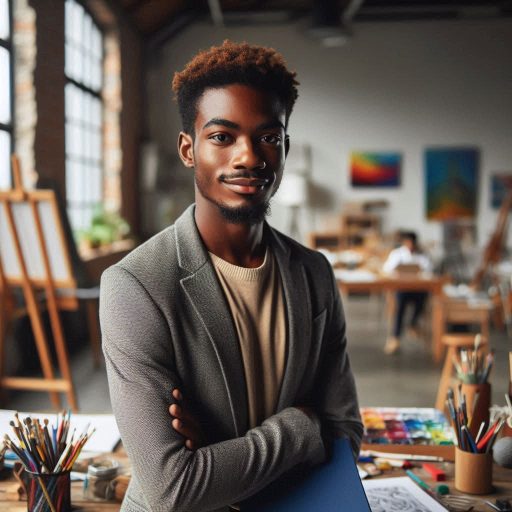Introduction
Collaboration in art education is essential for enhancing teaching effectiveness and enriching students’ learning experiences.
By working together, art educators can share valuable insights and strategies, creating a more dynamic and engaging learning environment.
The importance of collaboration lies in its ability to combine diverse expertise and perspectives.
When art educators collaborate, they pool their knowledge and skills to address various challenges.
This collective approach leads to innovative solutions and effective teaching methods that benefit students.
Working with other art educators offers numerous benefits.
First, it fosters professional growth.
Educators can learn new techniques and approaches from their peers, expanding their own teaching repertoire.
This exchange of ideas often results in more creative and effective lesson plans.
Second, collaboration helps in building a supportive professional network.
Sharing experiences and challenges with colleagues provides emotional support and encouragement.
This network can be a valuable resource for troubleshooting issues and gaining new perspectives.
Third, collaborating allows educators to share resources.
Teachers can exchange art supplies, lesson plans, and digital tools.
This sharing not only saves time and money but also enhances the quality of the educational materials available to students.
Introducing the idea of sharing resources and ideas is crucial for improving teaching practices.
By working together, educators can develop a shared repository of best practices and innovative ideas.
This collaborative approach ensures that teaching methods remain current and relevant.
In fact, collaboration among art educators is vital for personal growth and the advancement of teaching practices.
By working together, educators enrich their professional lives and provide more effective and engaging learning experiences for their students.
Transform Your Career Today
Unlock a personalized career strategy that drives real results. Get tailored advice and a roadmap designed just for you.
Start NowEstablishing a network of art educators
The importance of building relationships with other art educators
Building relationships with other art educators is crucial.
Collaboration fosters creativity and supports continuous growth.
When art educators share insights, they enhance their teaching methods and student engagement.
Strong networks provide a platform for exchanging ideas and resources, leading to innovative approaches in the classroom.
Tips on how to connect with colleagues in the field
To connect with colleagues, start by attending art education conferences and workshops.
These events offer opportunities to meet peers and learn from their experiences.
Join professional organizations dedicated to art education.
Being part of these groups can open doors to collaborative projects and new partnerships.
Utilize social media platforms to stay connected.
Join art educator groups and participate in discussions to exchange ideas.
Follow influencers and experts in the field to gain insights and stay updated on trends.
Engaging with online communities can lead to meaningful connections and collaborative opportunities.
The value of networking for professional development
Networking is invaluable for professional development.
It provides access to a wider range of resources and perspectives, enriching your teaching practice.
By learning from others, you can adopt new techniques and strategies that improve your effectiveness as an educator.
Additionally, a strong network can offer support and advice during challenging times.
Collaborating with fellow art educators not only benefits your professional growth but also enhances your students’ learning experiences.
Building a network of supportive colleagues fosters a collaborative environment where creative ideas flourish.
Investing time in establishing and nurturing these relationships will ultimately lead to a more fulfilling and successful career in art education.
Showcase Your Business Today
Reach thousands of readers actively exploring professional services. Publish your business profile and grow your audience now.
Publish NowRead: Marketing Yourself as a Costume Designer
Planning collaborative projects
Initiating and Planning Collaborative Projects
When initiating a collaborative project with other art educators, it is essential to start with clear communication.
Identify a common goal or theme for the project that aligns with the curriculum goals of all parties involved.
Establish roles and responsibilities for each educator, outlining what tasks need to be accomplished and by when.
Create a timeline for the project, including deadlines for brainstorming, planning, execution, and reflection.
Utilize digital tools for collaboration, such as Google Drive or Slack, to share resources, ideas, and feedback in real-time.
Schedule regular check-ins or meetings to discuss progress, address any challenges, and make adjustments as needed.
Examples of Successful Collaborative Art Projects
One successful collaborative art project is a community mural created by different art classes in a school.
Each class contributed a section of the mural, showcasing their unique style and creativity while uniting to create a cohesive piece.
Another example is a cross-school art exhibition where educators from multiple schools collaborate to curate and showcase student artwork.
This project not only fosters collaboration among educators but also provides students with a platform to share their artistic talents with a wider audience.
Collaborative art projects like these not only showcase the diversity of artistic expressions but also promote a sense of community and shared accomplishment.
Enhancing Creativity and Innovation in Teaching
Working with other art educators can spark creativity and innovation by bringing fresh perspectives and ideas to the table.
Collaborating allows educators to pool their resources, expertise, and experiences to create richer and more engaging learning experiences for students.
Through collaboration, educators can experiment with new teaching methods, materials, and approaches that they may not have considered on their own.
Interacting with colleagues can reignite passion for teaching and inspire educators to continually improve their practice.
Moreover, collaborative projects can help educators stay current with trends in art education and adapt their teaching strategies to meet the evolving needs of students.
In short, collaborating with other art educators can be a rewarding experience that enhances teaching practices, fosters creativity, and promotes a sense of community within the field of art education.
Read: Finding Freelance Opportunities as Art Instructors

Sharing resources and ideas
When collaborating with other art educators, sharing resources and ideas is key to fostering a strong community.
Here are some ways to effectively share resources and ideas with your peers:
Online Platforms
Utilize online platforms such as social media groups, forums, and websites dedicated to art education.
These platforms provide a space for art educators to share resources, lesson plans, and tips with one another.
Collaborative Projects
Engage in collaborative projects with other art educators to exchange teaching materials and lesson plans.
This hands-on approach allows for a deeper understanding of different teaching methods and fosters creativity.
Workshops and Conferences
Attend workshops and conferences specifically designed for art educators.
These events provide opportunities to network with colleagues, share ideas, and gain inspiration for your own teaching practice.
By sharing resources and ideas with other art educators, you can benefit in various ways:
Diverse Perspectives
Exchanging teaching materials and lesson plans with other educators exposes you to diverse perspectives and approaches to art education.
This can help you broaden your own teaching methods and strategies.
Professional Growth
Collaborating with other art educators encourages continuous learning and growth.
By working together with your peers, you can stay updated on the latest trends and innovations in the field of art education.
Enhanced Creativity
Sharing resources and ideas with other art educators can spark creativity and innovation in your own teaching practice.
By collaborating with others, you can discover new techniques and approaches to art education.
Overall, collaborating with other art educators through sharing resources and ideas is a valuable way to enhance your teaching practice and contribute to the larger art education community.
Embrace collaboration as a means of professional development and growth.
Read: Tips for Creating Cosplay Costumes
Uncover the Details: Understanding Fashion Design Runway Shows
Encouraging Peer Feedback
The Importance of Receiving Feedback from Other Art Educators
Receiving feedback from fellow art educators is crucial for professional growth.
Peer feedback offers fresh perspectives and new ideas.
Showcase Your Business Today
Reach thousands of readers actively exploring professional services. Publish your business profile and grow your audience now.
Publish NowIt helps educators identify strengths and areas needing improvement.
Constructive criticism from colleagues can reveal blind spots in teaching methods.
Engaging with peers fosters a collaborative learning environment.
It enhances teaching practices by incorporating diverse approaches and techniques.
Peer feedback supports continuous development and refinement of instructional strategies.
Strategies for Giving and Receiving Constructive Criticism
Effective peer feedback requires thoughtful strategies.
When giving feedback, be specific and focus on observable behaviors.
Offer suggestions for improvement rather than vague comments.
Frame feedback positively to motivate rather than discourage.
Use examples to illustrate points clearly.
When receiving feedback, listen actively and avoid becoming defensive.
Reflect on the feedback to understand its value.
Ask clarifying questions if needed and express gratitude for the input.
Implementing feedback thoughtfully can lead to significant improvements in teaching practices.
How Peer Feedback Can Improve Teaching Practices and Student Outcomes
Peer feedback enhances teaching practices by introducing new techniques and perspectives.
It encourages educators to adopt innovative methods and refine existing ones.
Collaboration with peers often leads to the development of more effective lesson plans and teaching strategies.
This, in turn, improves student engagement and learning outcomes.
Students benefit from more diverse and dynamic teaching approaches.
By incorporating peer feedback, educators can continuously evolve and enhance their teaching methods, leading to better educational experiences for their students.
Read: Innovative Teaching Strategies for Art Instructors
Collaborating on professional development opportunities
The benefits of attending conferences and workshops with other art educators
Collaborating on professional development can greatly enhance the growth of art educators.
Attending conferences and workshops with peers offers several benefits.
These events provide a platform for educators to exchange ideas and share innovative teaching methods.
Networking with fellow art educators can inspire new approaches and techniques in the classroom.
Additionally, conferences often feature renowned speakers who present the latest trends and research in art education.
This exposure can broaden your knowledge base and keep you updated on industry advancements.
Ways to collaborate on professional development opportunities
Exploring ways to collaborate on professional development opportunities can further enrich your experience.
Consider organizing joint workshops or training sessions with colleagues from different institutions.
Co-hosting events allows for a diverse exchange of ideas and resources.
Creating study groups or professional learning communities within your area can also be beneficial.
These groups can meet regularly to discuss new strategies and review each other‘s teaching practices.
Collaborating on curriculum development or lesson planning with fellow educators can lead to more creative and effective teaching solutions.
The value of learning from and with colleagues in the field
Learning from and with colleagues in the field adds immense value to professional growth.
Peer feedback is crucial for refining teaching techniques and addressing challenges.
Observing colleagues‘ teaching styles and classroom management strategies can offer fresh perspectives and ideas.
Engaging in collaborative projects with other art educators fosters a sense of community and shared purpose.
This collaborative environment encourages continuous learning and professional development.
It also helps build strong professional relationships, which can provide support and encouragement throughout your career.
All in all, collaborating on professional development opportunities allows art educators to expand their skills and knowledge.
Showcase Your Business Today
Reach thousands of readers actively exploring professional services. Publish your business profile and grow your audience now.
Publish NowAttending events together, working jointly on projects, and learning from peers all contribute to a more dynamic and effective teaching experience.
Conclusion
Collaborating with other art educators is vital for fostering a dynamic and enriching educational environment.
When educators join forces, they pool diverse perspectives and expertise, enhancing the overall quality of art education.
This collaborative spirit encourages creativity and innovation, benefiting both educators and students alike.
Sharing resources, ideas, and feedback amplifies the impact of individual efforts.
Resources such as lesson plans and teaching materials become more effective when shared.
Educators can adapt and improve these resources based on collective experiences, leading to more engaging and relevant lessons.
Moreover, exchanging ideas can spark new approaches and methodologies, enriching the teaching practice.
Feedback from peers provides valuable insights into what works well and what needs improvement, helping educators refine their techniques.
Encouraging readers to seek out collaboration opportunities can lead to significant growth in their art education practice.
Joining professional networks, attending art education conferences, and participating in online forums are excellent ways to connect with fellow educators.
By engaging in collaborative projects or workshops, educators can gain new perspectives and skills.
Building a network of supportive colleagues can also provide ongoing motivation and encouragement.
Collaboration among art educators is essential for professional growth and effective teaching.
Sharing resources, ideas, and feedback strengthens educational practices and enriches the learning experience for students.
Embrace opportunities for collaboration to continuously improve and innovate in your art education practice.
[E-Books for Sale]
The Big Book of 500 High-Paying Jobs in America: Unlock Your Earning Potential
$19.99 • 500 High-Paying Jobs • 330 pages
Explore 500 high-paying jobs in America and learn how to boost your career, earn more, and achieve success!
See All 500 High-Paying Jobs of this E-Book
1001 Professions Without a Degree: High-Paying American Jobs You Can Start Now
$19.99 • 1001 Professions Without a Degree • 174 pages
Discover 1001 high-paying jobs without a degree! Unlock career tips, skills, and success strategies for just $19.99!




